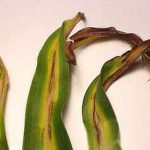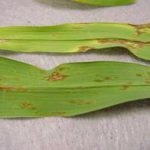The Hancock County Master Gardener Association maintains a daylily garden on the grounds of the Hancock County Extension Service. Earlier this spring we noticed some yellow/brown streaking down the length of the daylily leaves. After some investigation between one of our members and our Extension Educator, a diagnosis of the problem was made. It was Daylily leaf streak. Several of us went home to inspect our own daylilies and, unfortunately, discovered the problem existed outside of our demonstration garden at the Extension Service. Some of you may have noticed similar signs of disease on your own daylilies this year, especially since conditions have been ideal for the development of this fungal disease. Those conditions include warm, wet weather. The culprit pathogen responsible for this problem is Aureobasidium Microstictum?
Typically, leaf streak is a cosmetic problem but, in some cases, it can cause significant leaf loss, eventually weakening the plant. Along with yellowing that begins at leaf tips and spreads along and outward from the mid veins of the leaves, red/brown spots may also be present. These spots enlarge and turn brown, then become surrounded by yellow halos.
The fungal pathogen that causes this disease can over-winter in leaf debris, producing spores that infect new leaves each spring.
Control of the disease includes removing infected leaves as they appear. Fertilizing and adequate watering will encourage new leaf growth. However, avoid watering overhead with a sprinkler as this can spread the pathogen. Instead, use a soaker hose or drip hose. Also, avoid working with infected plant material when wet as this can spread the disease. To eliminate a source of the disease, cut back the dead leaves in the fall and remove the leaf debris. You can burn (where allowed, deep bury or hot compost the debris. Placing debris in plastic trash bags for removal is another option if the other options are not available to you. Further actions to reduce the chance of re-infection is to divide plants and replant, leaving more space between plants to improve air circulation and drying of leaves.
If the problem persists every year, consider applying a fungicide containing chlorothalonil, mancozeb, or thiophanate-methyl (read the labels before purchasing). Treat only during periods of wet weather. By that, I don’t think the experts are recommending applying the fungicide in a downpour but during periods when there has been frequent rain and humidity. You can also start applications before symptoms appear. Then treat every seven to fourteen days as long as wet weather persists. To be most effective, alternate the use of at least two active ingredients to minimize the development of resistant strains of the fungus. As always, read and follow label instructions of the fungicide to insure safety as well as effectiveness.
Stay tuned for more articles on plant diseases caused by warm, humid conditions.